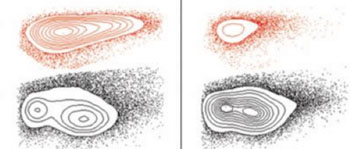Shutting Down Multiple DNA Synthesis Pathways Cures Leukemia in Mouse Model
By LabMedica International staff writers
Posted on 11 Mar 2014
Drug treatment that combined inhibitors of both the de novo (DNP) and salvage (NSP) pathways for DNA synthesis cured acute lymphoblastic leukemia (ALL) in a mouse model of the disease.Posted on 11 Mar 2014
Investigators at the University of California, Los Angeles (USA) blocked the DNP synthesis of DNA by treating ALL mice with thymidine. This treatment was not sufficient to prevent growth of cancer cells, which switched to the NSP pathway.

Image: The number of leukemia cells (red) was greatly reduced in treated (right) vs. untreated (left) mice while sparing any significant damage to normal blood cells (black) (Photo courtesy of the Rockefeller University Press).
To block the NSP pathway the investigators administered DI-39, a new high affinity small-molecule inhibitor of the rate-limiting enzyme DC kinase (DCK). DCK is required for the phosphorylation of several deoxyribonucleosides and their nucleoside analogs. Deficiency of DCK is associated with resistance to antiviral and anticancer chemotherapeutic agents. Conversely, increased DCK activity is associated with increased activation of these compounds to cytotoxic nucleoside triphosphate derivatives. DCK is clinically important because of its relationship to drug resistance and sensitivity.
The investigators reported in the February 24, 2014, online edition of the Journal of Experimental Medicine that a therapeutic regimen that simultaneously co-targeted the DNP pathway with thymidine and the NSP pathway with DI-39 was effective against ALL models in mice, without detectable host toxicity.
"This new dual targeting approach shows that we can overcome the redundancy in DNA synthesis in ALL cells and identifies a potential target for metabolic intervention in ALL, and possibly in other hematological cancers," said senior author Dr. Caius Radu, associate professor of molecular and medical pharmacology at the University of California, Los Angeles. "This interdisciplinary study not only advances our understanding of DNA synthesis in leukemic cells but also identifies targeted metabolic intervention as a new therapeutic approach in ALL. Clinical trials will be required to establish whether these promising findings will translate into a new therapeutic approach for ALL."
Related Links:
University of California, Los Angeles













